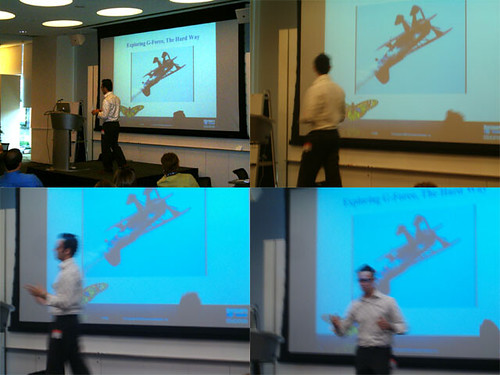Having survived my 4th consecutive year presenting at MICCA & a few other places, I think it’s safe for me to say I know one or two things about it. At least, I’ve yet to have a session that ended emptier than when it started, so I’ve got that going for me.
So here’s a list of 10 things that, if done correctly, will help your audience stay engaged and secure in the fact that you know what you’re talking about. (Or at the very least, they’ll help you fake it.)
They’re numbered, but the order could be changed. I’m not giving much thought to that part.
10. Market yourself. Don’t spend too much time on this, but your audience should know why you’re worth listening to on this subject. Are you a DEN Star? Google Certified? Do you have 20 years experience working with Web 2.0 technology? (OK, maybe in dog years…) Spend 30 seconds telling them why you’re special. Letting them know how to contact you if they have more questions later is good, too.
9. Don’t sit down. Some people can get away with it, but most of us can’t. An enthusiastic presenter is more likely to capture an audience, and you can show your enthusiasm better while up and moving.
8. Podiums are walls. Even if they aren’t the big, bulky, “This could stop a truck and still be usable” podiums, they create a barrier between you and your audience. Don’t hide behind one unless you audience scares you. (In fact, don’t use one then, either. Audiences can smell fear.)
7. PowerPoint is there to back you up. Not the other way around. Substitute “PowerPoint” for “Keynote,” “Prezi,” “Google Presentation,” or whatever you intend to use. If all you’re doing is reading your slides, you’re wasting space, time, and potentially oxygen.
6. Limit yourself. Just because a product or service can do 53,781 different things does not mean you have to cover all of them. Tying in with #7: Just because PowerPoint has a plethora of transitions does not mean you should try to use all of them in a single session. “Random” is the worst possible transition choice ever. In both cases, you should pick your favorites and stick with those.
5. Ask questions. Your audience is full of intelligent people. (Granted they’re listening to you, but there’s no reason to let them know that’s a strike against them!) The questions you ask could be ones that just check to see if they’re paying attention or ones that change the course of your discussion topic, but they should have some way of knowing that you’re acknowledging their presence.
4. Don’t print your PowerPoint. I’m not just saying that because as I type this it’s Earth Day. I’m saying this because paper is made of matter. The science geeks out there (including me) will be happy to tell you that means it has mass and volume, and that means 2 reasons why your audience will resent your 10 page printout once it’s added to all the other printouts they’ve collected at that conference. It adds up and shoulder pain is serious business. Do them and yourself a favor and make a wiki with all the useful information on it. Share the link at the beginning and end of your presentation and everyone will be happier for it.
3. Don’t admit mistakes that don’t mater, but admit the ones that do. So you wanted to cover 21 different Web 2.0 sites and skipped #17? Forget about it. If you have a wiki (you read #5, right?) they’ll be able to find ay small points you missed on there. But remember that with the exception of my 2nd grade teacher, we’re all human. Breathe deep, correct it if you can, acknowledge it if you can’t, and move on. Your audience will respect you more or it, trust me.
2. Have a backup. PowerPoint will crash. The network will go down. Something will go horribly wrong if you don’t have a plan B. When I’m talking about websites I’ll usually have screen captures of all the features I want to showcase, just in case. I learned this lesson the hard way. I will not share that story.
1. Your presentation will never be finished. I’ve seen keynote speakers changing slides shortly before they presented. I myself have redone a presentation several times, then scrapped the whole thing to start over again because I wasn’t satisfied. Leonardo da Vinci reportedly said “Art is never finished, only abandoned.” That you want to keep making it better is admirable, but don’t stress out that you’re not “done.”

Oh so now you come out with tips! JK I really like the hint about asking questions and something I will make sure to include next time. Totally agree on the no printing issue. No matter how great the handout, I never looked at them again after a week. Kudos on a job well done at MICCA!